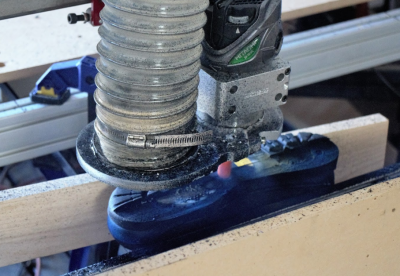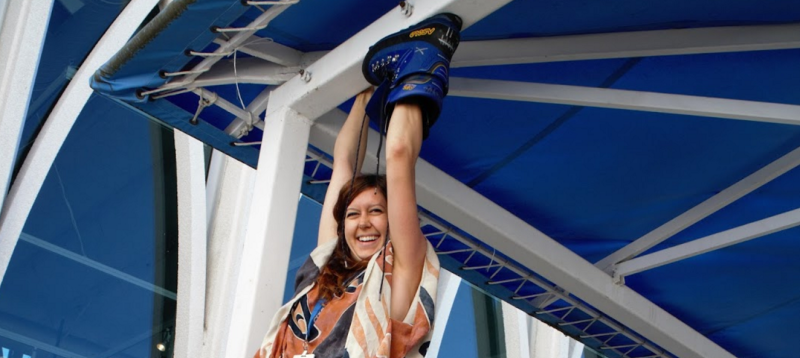While most of us stick to electronics around here, the few and the proud can also manage to stick to walls and ceilings. [Jen] is among these folk with the beginnings of a pair of magnetic boots that will easily keep her hoisted up in the iron rafters à la Dracula. And all this is just to get folks excited about STEAM education at her local science center.
 To engineer this pair, [Jen] started by giving each boot just over 130 pounds of pull such that each boot could independently hold her weight. She then shaved down a few mils off the boot with the nearby Science Center’s CNC router. A few drilling operations later and [Jen] is ready to show the world how to collect those hard-to-reach rupees on the ceiling.
To engineer this pair, [Jen] started by giving each boot just over 130 pounds of pull such that each boot could independently hold her weight. She then shaved down a few mils off the boot with the nearby Science Center’s CNC router. A few drilling operations later and [Jen] is ready to show the world how to collect those hard-to-reach rupees on the ceiling.
It’s one thing to dream about these shoes; it’s a whole different world to make this pair come to life. In case you’re looking to add a few other nifty pairs of footware to your closet, have a look at this springloaded pair that improves your walking efficiency.
















The first problem I see here is that I imagine it will be difficult to “walk” in them because permanent magnets were used. Colin Furze made a pair out of home-brew electromagnets. The problem there is powering them, but at least you can release them to walk easier.
Its nice to see a non-electronics hack every once in a while.
I guess this crazy Brit has topped it all: Colin Furze DIY X-MEN MAGNETO walking upside down with magnetic shoes https://www.youtube.com/watch?v=ZR0EJ7fA3Xw
you could at least post a link to the actual video instead of a poor quality repost.
https://www.youtube.com/watch?v=OqLi6lrOCzs
Seconded, thanks.
An ideal design could involve permanent magnets and electromagnets. Permanent magnets to hold you to the surface, and electromagnet assemblies (such as a voice coil) to mechanically push the boot off the surface. That way you would only have to energize the electromagnets for a split second to release the boot.
Kinda like how a latching relay only needs to be energized to change states rather than needing to be energized to hold a state.
Also, she should put in a safety factor! If she weighs 130lbs she should not have the boot’s max pull force be equal to her weight! Throw in a variety of real world environmental variables and she could be in for a fall!
One solution could be an EPM: https://en.wikipedia.org/wiki/Electropermanent_magnet
I suppose those two issues kind of go together. Without the electromagnet to release her foot any strength she adds to the magnet is strength she will need in order to be able to take a step.
The simplest way around that is to “unzip” the shoe, by progressively unsticking the magnets on one side of the sole and moving along.
Another way is with switching magnets, there are various systems like rolling cylindrical magnets (and you can configure them in an halbach array), magnet sliding in front of an non magnetic material (like magnetic chucks).
And then electromagnetic systems, like countering the permanent magnets with an electromagnet, or directly using the electromagnet.
Interesting idea, if you had the magnets on caterpillar tracks, do you think the force of the front one attracting itself down would counteract the force of the one pulling off sufficiently? I don’t mean perpetual motion style, I just mean so you don’t have to supply excessive force to move linearly.
Here’s another way to do it. This works really well in practice.
https://en.wikipedia.org/wiki/Magnetic_base
This is similar to how non-electric mag drills work – you just have two permanent magnets and they are rotated such that their magnetic fields either add or cancel each other out.
I still prefer that: https://en.wikipedia.org/wiki/Halbach_array#Variable_flat_arrays
Very cool idea!
For walking, perhaps it’s better do do something like ski-boots, and have the magnet assembly be detachable. You’re really going to want to take them off when walking on the ground, so that they don’t get clogged with magnetite from dirt and other ferrous debris.
Then perhaps you can have the portion with the magnets slide slightly forward/backward, and a cam push/pull the magnets.
i.e. rear foot pushing backwards extends cam/magnets, front foot pushing forwards retracts cam/magnets. A few mm of travel could be enough.
It won’t quite be a natural walking gait, but it’s simple and doesn’t require electricity.
And if you leave a bit of sole material covering the magnets, it will make you less likely to slip on inclined surfaces, and might cause some debris to drop of when retracted.
(And it may protect the magnets a bit from impact.)
Actually, EMs are more difficult because they will completely release your foot and then you won’t be able to get them back up. NASA has tried this and found it didn’t work. The PMs in this project are surprisingly easy to release if you pull the right way.
What, no Arduino with blinking lights?
Your just jealous because she has boot while you are literally barefoot.
You think he’s got problems?
“magnetic chuck”, then you just need a small servo to rotate the array. ;)
I did about three double takes on the picture. I thought the lady (in some gymnastic contortion) had got her leg over her head. I figured if you could do that, you don’t need magnetic boots.
Batman’s sleeping apparel.
Wait… Wait… She screwed some magnets to a boot? … and that’s it???….
…..
What am I missing here…
“Woman” “STEAM” (since apparently “art” is something we need more of).
If she actually wore them and walked upside-down, ie they WORKED, then that would be very cool. But wearing the boot on her hand says everything metaphorically as welll as literally.
EVEN THOUGH SHE USED A CNC ROUTER!
Thing about hacks is they actually work. Unless someone walks upside-down in these, without breaking an ankle or their skull, then this is “derp! I stuck magnets to something!”.
I see nothing repulsive about this very attractive idea.
I see what you did there!